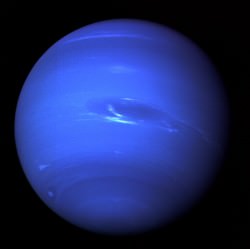It takes a nice safe environment for planets to form, according to new data gathered by the Spitzer Space Telescope. The powerful infrared observatory recently observed powerful O-type stars in the process of stripping away nearby planet-forming disks. The gigantic stars can have as much as 100 times the mass of the Sun, and generate killer solar winds. In one case, the planetary disc takes on a comet-like appearance, as planetary material is blown away from the star.
Continue reading “Planets Can’t Form in Rough Neighbourhoods”
Hubble Finds Distant Extrasolar Planets
The Hubble Space Telescope has identified 16 stars that could have extrasolar planets. The discoveries were made as part of a new Hubble survey, called the Sagittarius Window Eclipsing Extrasolar Planet Search (SWEEPS). This survey looked at 180,000 stars in the central bulge of the Milky Way – 26,000 light years away. The discovery was made using the transit method, where planets dim their parent stars slightly as they pass in front. Further observations will be needed to actually calculate the mass of the transiting planets.
Continue reading “Hubble Finds Distant Extrasolar Planets”
Nearby Universe Mapped in 3 Dimensions
A new map developed by an international team of astronomers should help you find your way around the Universe – at least to a distance of 600 million light years. This new 3-dimensional map plots out the locations of all the major superclusters of galaxies and the voids that surround them. It was developed using data from the 2MASS Redshift Survey, which calculated the redshifts (and therefore the distances) of 25,000 galaxies across the entire sky.
Continue reading “Nearby Universe Mapped in 3 Dimensions”
Are There Oceans on Neptune?

Continue reading “Are There Oceans on Neptune?”
Podcast: The Search for Dark Matter
Dark matter . . . What is it? Nobody knows for sure, but it’s definitely there. Or maybe it’s not there, and we just need some redefinition of gravity at vast scales. Join Fraser and Pamela as we discuss the discovery, detection, and possible explanations of dark matter.
Continue reading “Podcast: The Search for Dark Matter”
What’s Up this Week: October 2 – October 8, 2006
“Shine on… Shine on Harvest Moon… Up in the sky. I ain’t had no clear skies since January, February, June and July…” Oh! Greetings, fellow SkyWatchers! Welcome to this week’s edition where we’ll be taking a closer look a lunar features and just what makes a globular… Well… A globular! Time to get out the binoculars and telescopes and turn a eye to the sky, because…
Here’s what’s up!
Continue reading “What’s Up this Week: October 2 – October 8, 2006”
Giant Radio Telescope May Go to Australia or Africa
Australia and South Africa have been shortlisted to host the Square Kilometer Array, a massive radio telescope that will be built in 2018. The array will have thousands of antennas, spread out over an area of 3,000 km (1,800 miles), and should be 50 times more powerful than the most powerful array of radio telescopes we have today. The Australian site will be near Meekathara in the western side of the country, while the South African site will be near Carnarvon. Both sites were chosen because of the low interference of man-made radio signals in the surrounding countryside.
Continue reading “Giant Radio Telescope May Go to Australia or Africa”
First High Res Images from Mars Reconnaissance Orbiter
Now in its final science mapping orbit, NASA’s Mars Reconnaissance Orbiter is sending back some of the highest resolution images ever taken of the Red Planet. The images are so sharp, they show objects and features approximately 1 metre (3 feet) across. In addition to its high resolution camera, the spacecraft is equipped with a mineral-mapping spectrometer, a ground-penetrating radar, and a context camera for viewing large swaths of the planet.
Continue reading “First High Res Images from Mars Reconnaissance Orbiter”
A Closer Look at Planetary Formation
Astronomers have used the European Southern Observatory to map a vast disc of gas and dust surrounding a newly born massive star. The star is called HD 97048, and it’s located in the Chameleon I dark cloud, a stellar nursery 600 light-years away. The central star has 40 times the mass of our Sun, and the surrounding disc stretches 12 times further than the orbit of Neptune in our own Solar System.
Continue reading “A Closer Look at Planetary Formation”
Dark Spot in Uranus’ Clouds
The Hubble Space Telescope has discovered a giant cloud vortex in the upper atmosphere of Uranus. This cloudy feature measures 1,700 kilometers by 3,000 kilometers (1,100 miles by 1,900 miles) – large enough to engulf 2/3rd of the US. Although rare on Uranus, these cloud spots are actually quite common on Neptune, since the ice planet has a much more active atmosphere. Since this region of Uranus’ atmosphere was previously in shadow, astronomers theorize that heat from the sun created the vortex.
Continue reading “Dark Spot in Uranus’ Clouds”
